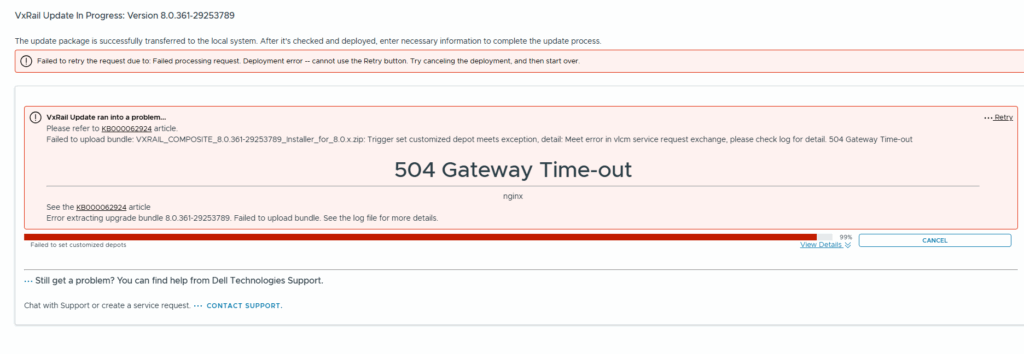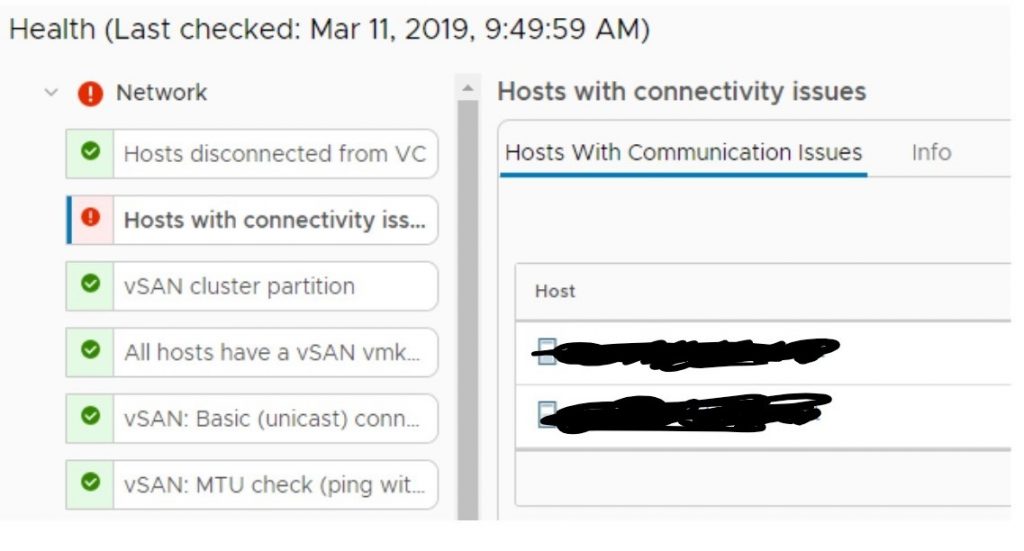
If you encounter a 504 Gateway Timeout error at 99% of the installation prerequisites, the issue may not actually be with VxRail itself. Instead, check the vCenter server task list and look for the vLCM task “Sync updates”
Continue reading
If you encounter a 504 Gateway Timeout error at 99% of the installation prerequisites, the issue may not actually be with VxRail itself. Instead, check the vCenter server task list and look for the vLCM task “Sync updates”
Continue reading

I have recently encountered the following error on several Lenovo VX systems, which prevents vLCM from initiating the upgrade from ESXi 7 to ESXi 8:
Error: Version iavmd-3.0.0.1038 of the manually added Component Intel VMD driver with VROC support is an unsupported downgrade from version iavmd-3.5.1.1002 on the host.
Replace the Component in the image with one of the same or higher version.

When a vSAN “cache” disk fails and gets replaced you need to rebuild the entire disk group that the cache disk belongs to. The normal way of doing this is to put the host in maintenance mode and then click the three dots next to the disk group and select “remove” (see picture below) – but unfortunately most of the time you get this error when trying to remove the disk group:
General vSAN error. vSAN disk data evacuation resource check has failed for disk or disk-group vsan: <UUID>

Luckily there is an easy way of removing the disk group from ESXi CLI that does seem to work every time (at least for me!). Enable SSH on the host containing the defective disk group. Locate the diskgroup UUID and run the following command (remember to replace <UUID>):
esxcli vsan storage remove --uuid <UUID>If you are unable to find the UUID for the diskgroup then you can run this command:
esxcli vsan storage listWhich will give you an output like this:

Important! – if your host has more than one disk group find the correct one by searching for an belonging disk (naa.xxxxxxx – first red arrrow). When a disk in the group that you need to delete is found, note the “vSAN Disk Group UUID” (second arrow) – this will be the UUID you need to delete with “remove” command mentioned earlier!
If you are uncertain what is going on here – then call VMware support. Deleting the wrong diskgroup can have fatal consequences!
For more information see VMware KB2150567 – link

Recently I saw this “error” in Skyline Health on a VSAN running version 7.U3o. The host that had the error was the virtual witness appliance.
Continue readingYou are not very likely to bump into Windows 2003 physical servers anymore – but nevertheless that just happened to me a week ago. The task was clear – this server needs to be virtualized into a vSphere 7 environment, running vSAN.
The problem with this task is that to convert (P2V) a 2003 server you need to install vCenter Converter 6.2 on it, since the latest release 6.3 simply doesn’t work on 2003 servers (It won’t install).
Next problem is that vCenter Converter 6.2 doesn’t work with vSAN 7 – only “traditional storage” can be used as target – but in this case there were no other storage than vSAN that could be used as target.
What to do? – read on…
I have lately been involved in two vSAN installation that had this alert in vSAN Health pane.

Another side effect is that the hosts on the warning list is unable to enter maintenance mode.
Continue readingA couple of days ago I was visiting a customer to setup their Lenovo host to run vSAN – after the initial setup of vSAN kernel IPs, disk groups and so on, I took a look at the “VSAN Health check” to make sure that everything was healthy and supported.
Under the “hardware compatibility” part all checkmarks where green, but the Controller firmware version was not detected – so I did found it a bit strange that it reports the disk controller as supported without knowing what version it actually was running.
![]()
![]()
This issue is not new to me, as I have seen it a couple of times before, but this time it was different after all.